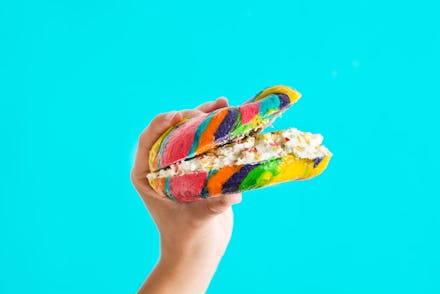Are food dyes and coloring safe?What you need to know about your favorite rainbow foods.

Rainbow bagels, galaxy donuts and multicolored muffins may just be the coolest foods to 'gram, but are the dyes making this multi-hued foods actually safe to consume?
In 2015, Kraft quietly replaced its artificial dyes and flavorings with all-natural substitutes in its beloved boxed macaroni and cheese, using ingredients like turmeric to color the cheese powder its luminescent orange hue. Since, several other brands have pledged to follow in Kraft's footsteps, most recently Nissin which removed all artificial flavors and added natural ingredients like turmeric, paprika and lime to Cup Noodle in September 2016.
While local bakeries and bloggers are whipping up colorful creations, corporate food giants are removing their food coloring in favor of health, so what's the deal with food dyes?
Food coloring can be both naturally derived (from plants and animals — yes, animals) and created synthetically. Dyes are usually flavorless, but add visual appeal to foods, like packaged chocolate cakes turned a rich chocolatey color by a mixture of red, blue and yellow dyes or farm-raised salmon given pigmentation pellets to turn their dank gray flesh into alluring, ruby-hued meat. All dyes used in foods, whether from artificial or natural ingredients, have to be approved by the Food and Drug Administration.
According to the American Chemical Society, both synthetic and natural food dyes, can cause health risks. Cochineal extract (red dye from beetles) as well as yellow dyes created with annatto and saffron can induce serious allergic reactions. A 2012 study from UCLA investigating the toxicology of food dyes concluded that many food dyes have not been adequately tested and "evidence for carcinogenicity, genotoxicity, and hypersensitivity, coupled with the fact that dyes do not improve the safety or nutritional quality of foods," should lead to greater caution and restraint in using food dyes.
Though limited research exists to prove that food coloring is actually dangerous, the Center for Science in the Public Interest is pressuring the FDA to ban all food dyes, insinuating that food coloring can pose health risks, including triggering hyperactivity in children and perhaps worse, luring children into eating junk food. Colorless Froot Loops and beige gummies don't seem all that enticing...
In a Slate piece published July 2016 entitled "Food Doesn't Have to Wear Makeup", gastroenterologist and assistant professor of medicine at Columbia University Medical Center Shilpa Ravella argued that food coloring is purposeless, only allowed in our broken food system to "make their processed products appear more palatable." Often made from the same pigments as actual cosmetic makeup, food dyes are disguising otherwise unappetizing foods into a rainbow of treats that you probably wouldn't eat without their colorful makeovers.
According to the FDA, food coloring is safe, but keep in mind the temptations of artificially brightly colored food compared to their natural or un-dyed iterations.